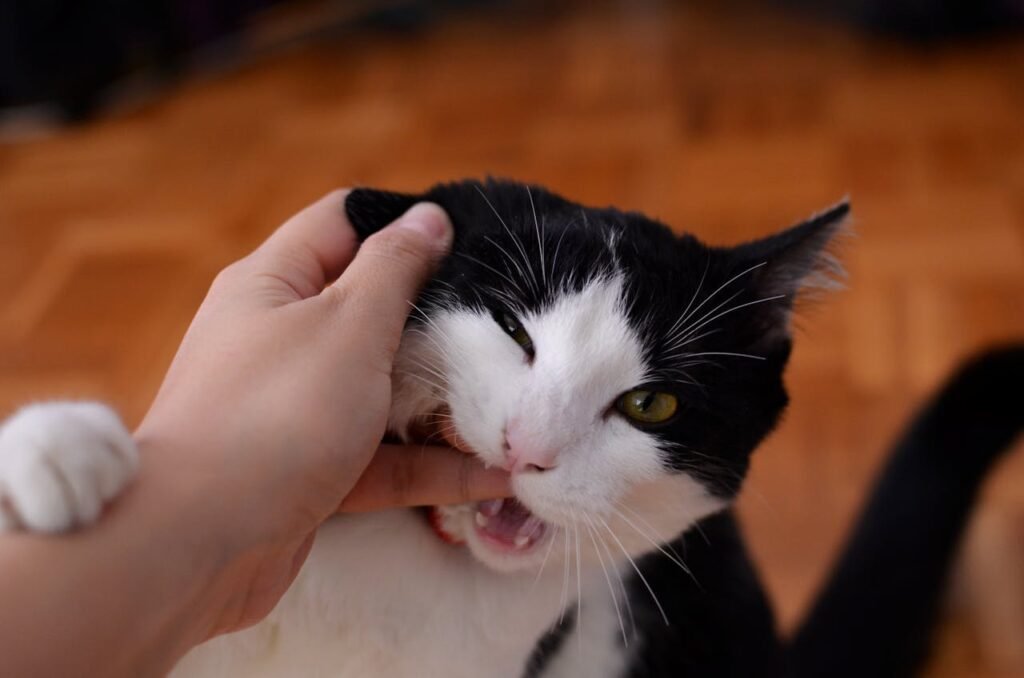Understanding Cat Behavior: Do They Know When They Misbehave? Last Updated on 22 Jan 2025, Care Kitties As cat owners we wonder …
Cat Biting: Understanding, Prevention & Treatment
Cats are known to bite for various reasons, and cat biting can be better managed by understanding why they do so—this is the ultimate way of handling the issue and avoiding its occurrence. Here, we will explain what causes cats to bite, how to distinguish signs that your cat is about to bite, and how to approach a solution to this kind of behavior through several methods that you can follow.
Understanding Cat Biting: Why Cats Bite:
Cats bite for a number of reasons: it may be a sign of expressing themselves or as a response to a given situation. Here are some common reasons:
Playfulness: Cats actively bite during the play activity, especially when they are still young or when they are kittens. This behavior resembles hunting, in which they jump on and bite their targets while chasing them.
Overstimulation: Interacting with a cat too much may only overwhelm it, and it will bite when it wants the petting to stop.
Fear or Pain: It is important because if a cat feels that danger is lurking or is in pain, then biting is one of the ways it will want to protect itself. I have a cat named Muffin, which is the best cat in our house. You can take her in your arms and move around a lot. But whenever someone unknown tries to touch her, she starts biting aggressively. We talked with the vet, and he said it is okay for her to do so as she needs time to adjust and get to know the person. But sometimes the cat can be in pain, and that can be a reason for her to bite.
Communication: As much as it is hard to understand, cats bite to communicate about their needs or due to pain. For instance, they might bite to communicate to the other person that they would like to be left alone or that they want some food.
Why Kittens Bite
Kittens bite for various developmental reasons, and it’s crucial to understand these to manage their behavior effectively. Kittens bite for various developmental reasons:
Teething: Particularly during the teething period, kittens start biting both objects and people to reduce pain.
Exploration: Naturally, biting is the procedure by which kittens investigate their environment and the objects in it.
Play: Scratching and biting are normal for the cats’ play and are part of their learning process in hunting and social structures.
Learning Limits: In both biting and being bitten, the kittens develop biting inhibition, hence learning the right pressure that they can apply without inflicting any harm on their peers.
That is why it is vital for kittens to stay with their mothers and littermates for a sufficient amount of time. Interestingly, social interaction with other kittens enables the young kitten to regulate its bite force while playing with its brothers or sisters. If you have adopted a kitten that was deprived of its mother at an early age, then you need to teach them these things. Our friend’s cat was deprived, and they let the cat bite them from an early age. As a result, the behavior of the cat could not be changed later on. So you must be very careful about that. Whenever you adopt such a cat, start training the cat not to bite as quickly as you can.
Cat Biting: Why Kitten Bites & Recognize Warning signs:
Identifying the signs before a cat bites can prevent the bite:
Twitching Tail: A quick flickering of the tails or constant beating of the tails denotes that the dog was furious or very enthusiastic.
Flattened Ears: Cats that have their ears flat against their heads are likely to bite.
Growling or hissing: These vocal signals are audible signals of alarm or threat.
Dilated Pupils: In this case, the pupil may represent an excited state, fear, or aggression.
Stiff Body Posture: When a cat’s muscles are rigid, this very often signals that the cat is ready to bite.
Steps to Stop Cats From Biting
1. Provide appropriate play outlets
You need to understand that cats are active animals, and they require something to focus on in order to not get bored and develop health problems. Ensuring they have appropriate outlets for their energy can reduce biting.
Interactive Toys: The toys, such as wand toys, laser pointers and balls, stimulate physical movement as well as hunting instincts, which helps the cat to be active and stop the biting behaviour.
Solo Play Toys: Puzzle feeders, toys containing catnip, and toys with an automator laser will greatly help to entertain your cat when you are not at home.
Scheduled Playtime: Daily playtime ensures your cat exercises and is less likely to consider your hand as a plaything.
2. Avoid using hands as toys
Another issue that needs to be closely monitored is the utilization of hands as toys.
Providing the cat with hands or fingers as toys can lead him or her to bite. Instead:
Use Toys: When playing, use toys only. This helps to train the cat that the hands of people are not objects for play.
Redirect Behavior: If your cat begins to bite your hands, this should be redirected towards a toy.
3. Teach bite inhibition
Teaching your cat that biting is unacceptable involves consistent reactions:
React Appropriately: After the bite, perform the sounds that kittens produce in high pitch to indicate that the bite is a painful one. This is the same kind of response that a kitten would get from a sibling—a littermate, to be precise.
Withdraw Attention: Withdraw from play and do not engage her or him in play again once she or he has bitten someone. This helps to show your kitty that biting will not continue the play and may even stop it all together.
Consistency is key: Stopping the attention immediately after the bite also helps to convince the cat that biting is wrong. Be consistent with this. Do not pay attention to the cat for some time consistently after each bite; the cat itself will know that she or he has done wrong.
4. Provide positive reinforcement
Encouraging good behavior is as important as discouraging bad behavior.
Treats and Praise: Praise them and offer some tasty treats, or pet them kindly once they have engaged in some playful sessions with no aggression.
Play Rewards: A cat is more likely to stop biting if they are given something to do they love or a special toy if they do not bite.
Clicker Training: Clicker training is another common and helpful form of training where one uses a clicker to mark good behavior. You can use this technique to stop the biting behaviour of your cat.
5. Create a calm environment
A calm, stress-free environment can significantly reduce biting.A calm, stress-free environment can significantly reduce biting.
Safe Spaces: Give hiding places, high areas your cat can be on to escape, such as a table or a desk, and other quiet areas where the cat may go if he or she feels threatened or stressed.
Routine: Feed your cat at fixed times throughout the day and establish a consistent playtime and nap schedule so that your cat recognizes that patterns remain constant.
Environmental Enrichment: You can add structures like scratching posts, climbing trees and window perches to ensure that the cat has something to do, which will help them to avoid stress.
6. Consult a vet
Persistent biting can be a sign of underlying health issues.Persistent biting can be a sign of underlying health issues.
Health Check: Take the cat to the vet and have it checked to see if there is any form of pain, sickness or any medical issues that might make the cat bite.
Pain Management: If you think or find out the cat is dealing with some health complications, ensure you seek an expert‘s opinion on the treatment and control of pain and discomfort in cats.
7. Consider a behaviorist
If biting persists despite your efforts, consulting a professional animal behaviorist can provide additional strategies:
Behavior Assessment: The behaviorist can find out the underlying problems that are initiating the biting behaviours of your cat.
Tailored Plan: After that, they can individually develop a program and solutions aimed at stopping the biting behavior of the cat.
What should you do if the cat is biting you?
If your cat bites you, it’s essential to handle the situation calmly and correctly.If your cat bites you, it’s essential to handle the situation calmly and correctly.
Stay Calm: This clearly shows that making gestures of anger or aggression only worsens the situation. In this case, let the cat exhaust its anger and do not act in a way that will trigger him or her further.
Gently Pull Away: Do not pull your hand or your body part back because doing so will result in the cat biting you even more. Rather, start slowly trying to free oneself from the cat’s embrace without seeming to rush the process.
Reflect on the Cause: Think about what could have provoked the bite in order to keep such accidents from recurring. Did you maybe pet your cat for too long? Did you keep on to them and actually offend or punish them unintentionally?
Possible Ways to Treat a Cat Bite
Clean the wound: The bite area should also be washed with soap and water to eliminate bacteria that could be present on the skin.
Apply Antiseptic: Since there is a cut that is deep, one needs to use an antiseptic to try and avoid such an instance.
Cover the Wound: After washing it, put on a clean bandage to cover the wound to avoid infections.
Monitor for Infection: This is a sign of infection and should be expected to show some of the symptoms, like redness, swelling or pus. In cases of infection, one should consult a doctor.
Read this article of ours for a better understanding of what to do if your cat bites you.
We hope this article has helped you to stop your cat from biting and you can have great moments together!!
Related Articles
Harness Training A Cat: An Eight-Step Guide Last Updated on 15 July 2024, Care Kitties Why harness training a cat is important …
Best Places to Bond With Your Cat Last Updated on 09 July 2024, Care Kitties It is necessary to take a perfect …
Top 11 Qualities that make you the Best Cat Parent Last Updated on 26 May 2024, Care Kitties Cats are adorable and …
Litter Training 101: Essentials for New and Experienced Cat Parents Last Updated on 20 May 2024, Care Kitties From birth, cats and …
Adopt, Don’t Shop: The Advantages of Pet Adoption Last Updated on 19 May 2024, Care Kitties We all want to have a …







